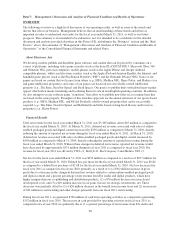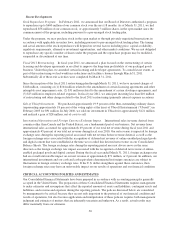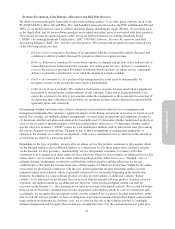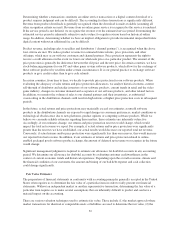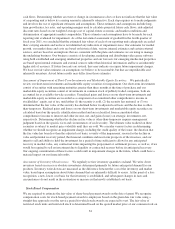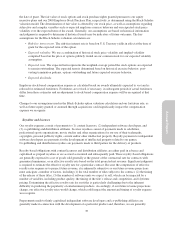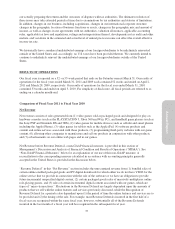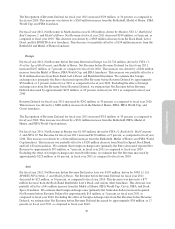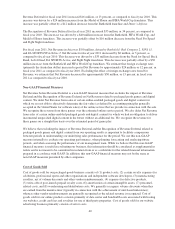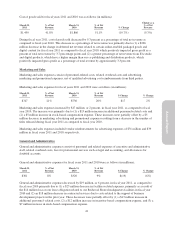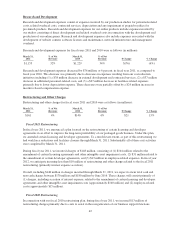Electronic Arts 2011 Annual Report Download - page 111
Download and view the complete annual report
Please find page 111 of the 2011 Electronic Arts annual report below. You can navigate through the pages in the report by either clicking on the pages listed below, or by using the keyword search tool below to find specific information within the annual report.
Annual Report
the date of grant. The fair value of stock options and stock purchase rights granted pursuant to our equity
incentive plans and our 2000 Employee Stock Purchase Plan, respectively, is determined using the Black-Scholes
valuation model. The determination of fair value is affected by our stock price, as well as assumptions regarding
subjective and complex variables such as expected employee exercise behavior and our expected stock price
volatility over the expected term of the award. Generally, our assumptions are based on historical information
and judgment is required to determine if historical trends may be indicators of future outcomes. The key
assumptions for the Black-Scholes valuation calculation are:
•Risk-free interest rate. The risk-free interest rate is based on U.S. Treasury yields in effect at the time of
grant for the expected term of the option.
•Expected volatility. We use a combination of historical stock price volatility and implied volatility
computed based on the price of options publicly traded on our common stock for our expected volatility
assumption.
•Expected term. The expected term represents the weighted-average period the stock options are expected
to remain outstanding. The expected term is determined based on historical exercise behavior, post-
vesting termination patterns, options outstanding and future expected exercise behavior.
•Expected dividends.
Employee stock-based compensation expense is calculated based on awards ultimately expected to vest and is
reduced for estimated forfeitures. Forfeitures are revised, if necessary, in subsequent periods if actual forfeitures
differ from those estimates and an adjustment to stock-based compensation expense will be recognized at that
time.
Changes to our assumptions used in the Black-Scholes option valuation calculation and our forfeiture rate, as
well as future equity granted or assumed through acquisitions could significantly impact the compensation
expense we recognize.
Royalties and Licenses
Our royalty expenses consist of payments to (1) content licensors, (2) independent software developers, and
(3) co-publishing and distribution affiliates. License royalties consist of payments made to celebrities,
professional sports organizations, movie studios and other organizations for our use of their trademarks,
copyrights, personal publicity rights, content and/or other intellectual property. Royalty payments to independent
software developers are payments for the development of intellectual property related to our games.
Co-publishing and distribution royalties are payments made to third parties for the delivery of products.
Royalty-based obligations with content licensors and distribution affiliates are either paid in advance and
capitalized as prepaid royalties or are accrued as incurred and subsequently paid. These royalty-based obligations
are generally expensed to cost of goods sold generally at the greater of the contractual rate for contracts with
guaranteed minimums, or an effective royalty rate based on the total projected net revenue. Significant judgment
is required to estimate the effective royalty rate for a particular contract. Because the computation of effective
royalty rates requires us to project future revenue, it is inherently subjective as our future revenue projections
must anticipate a number of factors, including (1) the total number of titles subject to the contract, (2) the timing
of the release of these titles, (3) the number of software units we expect to sell, which can be impacted by a
number of variables, including product quality, the timing of the title’s release and competition, and (4) future
pricing. Determining the effective royalty rate for our titles is particularly challenging due to the inherent
difficulty in predicting the popularity of entertainment products. Accordingly, if our future revenue projections
change, our effective royalty rates would change, which could impact the amount and timing of royalty expense
we recognize.
Prepayments made to thinly capitalized independent software developers and co-publishing affiliates are
generally made in connection with the development of a particular product and, therefore, we are generally
35





